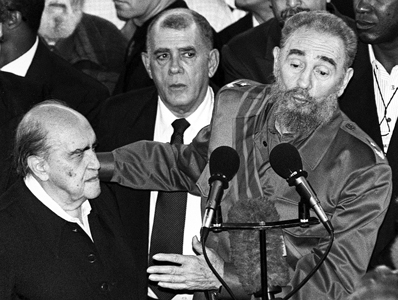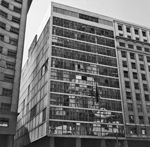You are in: Home page > Magazine Archive > Between the "Dolce Vita" and the Left

Oscar Niemeyer and Fidel Castro in 1999
Abstract
Died at almost 105 years, Niemeyer has experienced important times in the recent history of Brazil. Collaborator of Lucio Costa and fellow of President Kubitschek, the carioca architect has helped contributed in building essential parts of the country, making his language and his conception of the project to be not only an emblem of national development for a country with a relatively short history, but also a symbol of the country itself in the world.
Born on the 15 December 1907, Oscar Niemeyer died just ten days before celebrating his one hundred and fifth birthday. Notable longevity, above all if observed in parallel with the “youth” of the Brazilian nation, discovered by the Portuguese in 1500 and only proclaimed independent in 1822. His life occupied a fifth of this story and more than half of the period of national supremacy. His work, for this and other reasons, has an inaugural value, marking the artistic maturity of the country at the point when it entered the modern world. A cultural apprenticeship in which Brazil – as the modernist poet Oswald de Andrade loved to repeat – began to “nurture universal culture” instead of “flogging macumba to tourists”.
Niemeyer had a singular personality. He was a member of the so-called Clube dos Cafajestes, which combined the playboy and bohemian moods of the carioca élite of the forties and fifties, and at the same time a member of the communist party, close to figures like Luís Carlos Prestes and Fidel Castro. As a result, his public figure was divided between the relaxed climate of Rio’s dolce vita and the political/ideological commitment of the Left. Because for dialectic materialism conflict was considered a driving force of history, thanks to the adroitness typical of Copacabana, the bon vivant style was a strategy to overcome the hassles of daily life.
His career began in 1935-36, a moment when, as an apprentice in the offices of Lucio Costa (1902-98), Niemeyer personally assisted Le Corbusier in his projects for the Ministry of Education and Health (MES, currently Palácio Gustavo Capanema) and for the University of Brazil, both in Rio de Janeiro. For this reason, he ended up being included in the group that would later develop the final MES project under the guidance of Costa, revealing itself as decisive in the definition of the final solution adopted.
At this moment began a moving story of exchanges of position between Lucio Costa and Oscar Niemeyer in which the former – almost six years older – gradually handed over the sceptre of the group head to the latter, thereby giving a generous boost to his career.
Unlike Costa, more linked emotionally to the Portuguese artisan tradition, Niemeyer had a decidedly inspired and modern vocation, designing works of architecture that rapidly ended up being identifiable for their plastic emphasis and for the freedom with which they tackled the relationship between volume and structure. To draw a parallel, the graphic synthesis of his architectonic forms resembles the technical and gestural stylization of the singer Carmen Miranda (1909-55) who began to enjoy success in the United States right at the time when Costa and Niemeyer were building the Brazilian Pavilion at the 1939 Universal Exposition in New York. In both can be perceived a modern and original vocation that was at the same time accessible to the many. And if Carmen’s rather extravagant kitsch was to serve, decades later, as inspiration for tropicalism in popular music, Niemeyer would never be able to distance himself from being associated with a tropical regionalism, exotic and hedonistic, but which, nonetheless, was unable to describe the most important aspect of his work.
His celebrated love of the curved line of mimetic inspiration (landscape or biomorphic) more often than not hid the real constructive intelligence of his projects. This is the case, for instance, of the Boavista Bank (1946) in Rio de Janeiro, where the undulating design of an extended wall of reinforced concrete and glass tiles guarantees, precisely because of its shape, rigidity for the transparent surface which stands firm despite of its considerable height. In the same way, the enormous serpentine volume of the Copan building (1951-68) in São Paulo, favours the stability of the (somewhat flimsy) construction in relation to the immense strength of the wind which would otherwise tend to demolish it. Which means that we can rarely mark again the mere plastic gratuitousness of these free forms.
Recommended by Lucio Costa for the Grand Hotel project in Ouro Preto (1940), a modern intervention in the historical centre of the most important colonial city in the country, Oscar Niemeyer became aware of the authority of the State of Minas Gerais, and was subsequently invited by Juscelino Kubitschek (1902-76), then prefect of the state capital, to design a complex of buildings on the bank of Lake Pampulha (1940-43): a casino, a chapel, a club and a dancehall. These projects had huge repercussions in Brazil and abroad, and became a sort of emblem of the exhibition Brazil Builds, at New York’s Museum of Modern Art (MoMA), in 1943. After that the association between Niemeyer and Kubitschek, or between architecture and power, became symbiotic. If, on the one hand, the graceful monumentality of his buildings conceded a modern image of the State that inspired the development – a stickler for efficiency devoid of formulation, on the other, the state patronage had allowed the architect to develop work that was openly symbolic and public, free from the debasing constrictions of private patrons, subject to the laws of the market and the idiosyncrasies of personal taste.
This relationship, as we know, would culminate in the construction of Brasilia (1957-60), the new capital of the country designed in the desert hinterland of its territory in a period when Kubitschek became president of the nation (1956-61). With masterpieces like the Congresso Nacionale, the Cathedral (as well as the small church of Fatima), and the Alvorada and Itamaraty Palaces, Oscar Niemeyer, by then fifty, reached the summit of his career. Shortly before he had suffered harsh criticisms by European architects and theoreticians linked to Rationalism. The toughest came from the Swiss artist and designer Max Bill, who associated Oscar’s free forms with Decorativism and a wild world. Criticisms which, in the meantime, did not stop Niemeyer from creating works that were not exactly orthodox from a structural point of view in Brasilia, like the Alvorada Palace, where the elegant colonnade of the façade – whose form was widely copied by contemporary construction all over Brazil, constituting a sort a of new vernacular modernity – has a merely symbolic or better, scenographic function. The situation of Brazilian architecture is therefore rather curious: the great maestro of modernity was already, to some extent, also a postmodern pioneer.
The military coup of 1964, which would give birth to a twenty-year dictatorship, brusquely interrupted this alliance. It must be underlined that at that moment if a series of artistic movements in music, theatre, cinema, painting and sculpture debouched in open forms of contestation against the regime, architecture felt the absence of state patronage entering a decline. From being a laboratory of a new model of society, Brasilia became a symbol of military power. And of this phase remains the optimistic image of the Sinfonia da Alvorada (1960) composed by Antono Carlos Jobim and Vinícius de Moraes for the inauguration of the capital, and which became an incarnation of the monstrosity of the new times, as described in the song Tropicália (1967) by Caetano Veloso.
During his voluntary exile (from 1966 to the early '80s), Niemeyer built important works for the whole world – the headquarters of the French Communist Party (Paris, 1965-81), the headquarters of the Mondadori publishers (Segrate, 1968-75) and the University of Constantine (Argel, 1969-72), thus consolidating the international stamp of his work. However, in Brazil, the main axis of his architectural production shifted from Rio de Janeiro to São Paolo, the country’s industrial and financial centre, under the guidance of Vilanova Artigas (1915-85) and, later on, of Paulo Mendes da Rocha (1928). Tagged “Paulist Brutalism”, this architecture was based on criticism of the carioca formal freedom imposing on itself a militant constructive severity that found expression in the use of rough-cast reinforced concrete and structural didactics.
On returning to Brazil, in times of renewed political openness, Niemeyer met Leonel Brizola, the then governor of the State of Rio de Janeiro, for whom he designed the CIEP (Centros Integrados de Educação Pública, 1983), a series of schools realized through pre-fabricated concrete modules and the Sambódromo of Avenida Marquês de Sapucaí (1984) looking out over the Praça da Apoteose. Thus it was that the architect of the Vargas and Kubitschek eras also created the symbols of the so-called Nova República – the New Rebublic, and not only in Rio de Janeiro, but also in São Paolo with the Memorial da América Latina (1987) commissioned by Orestes Quércia, and later in Belo Horizonte, with the Cidade Administrativa de Minas Gerais (2007) on request of Aécio Neves. However, the costly formalism of the Memorial did not sit well with the less populist spirit of the new times. By the time he was in his eighties, Niemeyer was considered an architect from another time, a touch mannerist, a representative of a modern world dead and buried. It was the decade of postmodern effervescence and the lunar atmosphere of the arid piazzas punctuated by the smooth white buildings of Brasilia and the Memorial da América Latina was the antithesis of the contextualism then reigning.
What will be the inheritance of the Modern Movement? The ideology of progress left room to recover the past. But also, in the Brazilian case, a politicization that paid more heed to the social contradictions of a country that had grown a great deal in just a few decades and for which the perspective of a rational and organized development became a Utopian mirage. What would remain of the civitas of Brasilia’s superquadras in a country assailed by favelas, and in which its own federal capital was surrounded by a belt of satellite cities where extreme poverty held sway?
Niemeyer’s generation was unable to answer these questions. Nevertheless, Niemeyer himself lived so long that he surpassed the moment of the decline of his work giving the impression of being reborn with vitality in the final part of his life with projects like the Museum of Contemporary Art of Niterói (1991), and the Auditorium at the Ibirapuera Park (2002). At the beginning of the new millennium, when the modern lesson was being rediscovered, Niemeyer regained not only his national and international praise, but definitively entered the pantheon of the great masters of the 20th century. Heir of Aleijadinho and Le Corbusier, Oscar Niemeyer built the image of modern Brazil with a disinhibition very far from the Lusitanian sense of shame that marked the historic timidity of the visual arts in Brazil. As a result, as Darcy Ribeiro stated, this carioca architect might be the only Brazilian to be remembered in the thirtieth century.
Guilherme Wisnik, architect, historian and critic, teaches at the Faculty of Architecture of the University of São Paulo. Author of monographs, essays and articles has been one of the curators of the last Biennale of Architecture in São Paulo.















